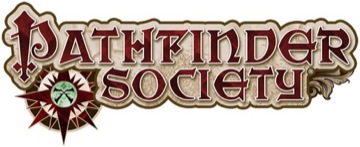One of the axiomatic truths of the Dungeons & Dragons “edition wars” is that 3.5/Pathfinder is the “system mastery” edition. Between the Open Gaming License opening the system to third party content and Wizards of the Coast’s business strategy around monthly releases of splatbooks, the 3rd and 3.5 Editions of the game quickly bloated with options for classes, prestige classes, feats, and spells. Paizo Publishing’s Pathfinder rebooted D&D 3.5 and fixed a number of issues with the system, particularly the resulting class imbalance, but it still embraced the variety of character options.
Yesterday, Paizo announced its new organized play campaign, Pathfinder Society Core Campaign. Amongst other differences from the existing Pathfinder Society campaign, this campaign will limit the character options to the Pathfinder Core Book and two small, free supplements. Paizo cites that one of the shortcomings of its existing Pathfinder Society campaign is “new players being overwhelmed or overshadowed by over-optimized characters.”
Catering to new players? Over-optimized? Don’t look now, but there’s a battle a-brewin’ between Wizards and Paizo.
***
Pathfinder is a fantastic system, but it was born with a silver spoon in its mouth; released in 2009, it was always the open source alternative to 2008’s D&D 4th Edition. It stood in stark contrast to the new mechanical design of 4th Edition, and benefitted from an open beta test to engage the 3.5E community. Owing to the ready conversion of 3.5E players, Pathfinder was wildly popular from its inception, and effectively split the market of D&D players by default. There aren’t many RPGs that can claim that kind of initial audience.
After five years without a direct competitor, Pathfinder is now facing its first major threat in the form of Dungeons & Dragons 5th Edition. Between the “D&D Next”-branded playtest/marketing event and the rejection of most of the controversial design decisions of 4E, this edition of D&D appears to be aimed directly at Pathfinder’s loyal fanbase. It seems to be working; virtual tabletop app Roll20’s gameplay numbers show the popularity of 5E is coming at the expense of Pathfinder.
With the release of the Dungeon Master’s Guide in December, the full D&D 5E core system is out there for consumption. 5E has streamlined mechanics–the free Basic Rules are only 115 pages–that harken back to 3.5 and Pathfinder. Last week, Wizards revealed its player-friendly plans for it’s latest campaign storyline, Elemental Evil. For new players considering Dungeons & Dragons and Pathfinder, D&D 5E looks like the easier system.
***
Faced with slowly losing their core audience and fighting back, Paizo has chosen to fight. They’ve picked an suprising way to do it in adapting their system to be friendlier to new players. Mind you, they haven’t changed the system, but rather have changed their engine for exposing new players: Pathfinder Society. I must confess, I have very limited experience with organized play campaigns, but they seem to be an important strategy for attracting and retaining players, since both Paizo and Wizards are dedicating quite a bit of resources to them.
This is the first time in the life of the Pathfinder system that it needs to drive its own growth to be successful. Where D&D 4E simply conceded Pathfinder a large audience, D&D 5E has aggressively pursued that audience. And for the advantages that Pathfinder had at launch and the success its had to date, it can’t hold a candle to Dungeons & Dragons. D&D is the flagship brand in the hobby. It has video games, novels, TV episodes, and full-on feature length films dedicated to it. This is an uphill battle against the brand-power of D&D and marketing budget of Wizards.
This is new territory for Pathfinder, and Paizo needs to be clever in how it adapts Pathfinder to the new marketplace if it can continue its growth. Paizo should be worried. If they are willing to scale down (or, as critics will say, dumb down) Pathfinder–a partial rejection of Pathfinder’s core design principle–it looks like they are.


Pingback: I Read Some Things: January 26th, 2015 | Mundangerous